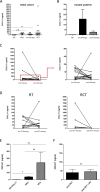Partial recovery of peripheral blood monocyte subsets in head and neck squamous cell carcinoma patients upon radio(chemo)therapy is associated with decreased plasma CXCL11
- PMID: 38609887
- PMCID: PMC11015641
- DOI: 10.1186/s12885-024-12177-x
Partial recovery of peripheral blood monocyte subsets in head and neck squamous cell carcinoma patients upon radio(chemo)therapy is associated with decreased plasma CXCL11
Abstract
Background: Head and neck squamous cell carcinoma (HNSCC) represents a common and heterogeneous malignancy of the oral cavity, pharynx and larynx. Surgery and radio(chemo)therapy are the standard treatment options and also have great influence on the composition of the tumor microenvironment and immune cell functions. However, the impact of radio(chemo)therapy on the distribution and characteristics of circulating monocyte subsets in HNSCC are not fully understood.
Methods: Expression patterns of adhesion molecules and chemokine receptors CD11a (integrin-α L; LFA-1), CD11b (integrin-α M; Mac-1), CD11c (integrin-α X), CX3CR1 (CX3CL1 receptor) and checkpoint molecule PD-L1 (programmed cell death ligand-1) were investigated upon radio(chemo)therapeutic treatment using flow cytometry. Furthermore, comprehensive analysis of plasma cytokines was performed before and after treatment using ELISA measurements.
Results: Our data reveal a partial recovery of circulating monocytes in HNSCC patients upon radio(chemo)therapeutic treatment, with differential effects of the individual therapy regimen. PD-L1 expression on non-classical monocytes significantly correlates with the individual plasma levels of chemokine CXCL11 (C-X-C motif chemokine 11).
Conclusions: Further comprehensive investigations on larger patient cohorts are required to elucidate the meaningfulness of peripheral blood monocyte subsets and chemokine CXCL11 as potential bioliquid indicators in HNSCC with regard to therapy response and the individual immunological situation.
Keywords: Adhesion molecules; CXCL11; Head and Neck squamous cell carcinoma; Monocyte subsets; PD-L1; Radio(chemo)therapy.
© 2024. The Author(s).
Conflict of interest statement
The authors declare no competing interests.
Figures






Similar articles
-
A systematic review and meta-analysis of prognostic indicators in patients with head and neck malignancy treated with immune checkpoint inhibitors.J Cancer Res Clin Oncol. 2023 Dec;149(20):18215-18240. doi: 10.1007/s00432-023-05504-5. Epub 2023 Dec 11. J Cancer Res Clin Oncol. 2023. PMID: 38078963 Free PMC article.
-
Spatial Transcriptome Analysis of B7-H4 in Head and Neck Squamous Cell Carcinoma: A Novel Therapeutic Target for Anti-Immune Checkpoint Inhibitors.Head Neck Pathol. 2025 Jun 30;19(1):78. doi: 10.1007/s12105-025-01815-w. Head Neck Pathol. 2025. PMID: 40586978 Free PMC article.
-
Elevated PD-L1 Expression on Circulating Classical Monocytes Upon Checkpoint Inhibitor Therapy Is Associated With Increased Plasma Interleukin 5 in Patients With Lung Cancer.Anticancer Res. 2025 May;45(5):1915-1925. doi: 10.21873/anticanres.17569. Anticancer Res. 2025. PMID: 40295054
-
Current studies of immunotherapy in head and neck cancer.Clin Otolaryngol. 2018 Feb;43(1):13-21. doi: 10.1111/coa.12895. Epub 2017 May 29. Clin Otolaryngol. 2018. PMID: 28464441
-
The immunologic landscape of HRAS-mutant head and neck squamous-cell carcinoma.ESMO Open. 2025 Aug;10(8):105538. doi: 10.1016/j.esmoop.2025.105538. Epub 2025 Aug 12. ESMO Open. 2025. PMID: 40803018 Free PMC article.
References
-
- Lacas B, Carmel A, Landais C, Wong SJ, Licitra L, Tobias JS, et al. Meta-analysis of chemotherapy in head and neck cancer (MACH-NC): an update on 107 randomized trials and 19,805 patients, on behalf of MACH-NC Group. Radiotherapy Oncology: J Eur Soc Therapeutic Radiol Oncol. 2021;156:281–293. doi: 10.1016/j.radonc.2021.01.013. - DOI - PMC - PubMed
MeSH terms
Substances
LinkOut - more resources
Full Text Sources
Medical
Research Materials
Miscellaneous

